ISSN ONLINE(2319-8753)PRINT(2347-6710)
ISSN ONLINE(2319-8753)PRINT(2347-6710)
R.Janci Rani, C.Tharanidharan
|
| Related article at Pubmed, Scholar Google |
Visit for more related articles at International Journal of Innovative Research in Science, Engineering and Technology
Energy is the major constraint in wireless sensor network. In multi hop network, which are the nodes located near to sink node consume high energy because of responsible for forwarding data from nodes that are farther away. The battery drained in a short time. In Proposed system, we introduce mobile sinks for data gathering multiple sensors in wireless sensor network. Initially we have to find rendezvous points (RP) in wireless sensor network. An approach proposed to handle this challenge is to make a hybrid moving pattern within which a mobile-sink node solely visits rendezvous points (RPs), as hostile all nodes. Sensor nodes that don't seem to be RPs forward their detected knowledge via multi hopping to the closest RP. The basic drawback then becomes computing a tour that visits of these RPs among a given delay certain. Distinctive the best tour, however, is NP-hard drawback. To handle this drawback, a heuristic known as weighted rendezvous planning (WRP) is projected, whereby every sensing element node is appointed a weight equivalent to its hop distance from the tour and also the variety of information packets that it forwards to the nearest RP. WRP is valid via intensive technique, and our results demonstrate that WRP permits a mobile sink to retrieve all detected knowledge among a given point in time whereas preserving the energy expenditure of sensor nodes. a lot of specifically, WRP reduces energy consumption by twenty second and will increase network life by a quarter mile, as compared with existing algorithms.
Keywords |
| WRP, Energy, Sink node. |
INTRODUCTION |
| A wireless sensor network (WSN) consists of sensor nodes capable of collecting information from the environment and communicating with each other via wireless transceivers. The collected data will be delivered to one or more sinks, generally via multi-hop communication. The sensor nodes are typically expected to operate with batteries and are often deployed to not-easily-accessible or hostile environment, sometimes in large quantities. It can be difficult or impossible to replace the batteries of the sensor nodes. On the other hand, the sink is typically rich in energy. Since the sensor energy is the most precious resource in the WSN, efficient utilization of the energy to prolong the network lifetime has been the focus of much of the research on the WSN. The communications in the WSN has the many-to-one property in that data from a large number of sensor nodes tend to be concentrated into a few sinks. Since multi-hop routing is generally needed for distant sensor nodes from the sinks to save energy, the nodes near a sink can be burdened with relaying a large amount of traffic from other nodes. |
| Sensor nodes are resource constrained in term of energy, processor and memory and low range communication and bandwidth. Limited battery power is used to operate the sensor nodes and is very difficult to replace or recharge it, when the nodes die. This will affect the network performance. Energy conservation and harvesting increase lifetime of the network. Optimize the communication range and minimize the energy usage, we need to conserve the energy of sensor nodes .Sensor nodes are deployed to gather information and desired that all the nodes works continuously and transmit information as long as possible. This addresses the lifetime problem in wireless sensor networks. Sensor nodes spend their energy during transmitting the data, receiving and relaying packets. Hence, designing routing algorithms that maximize the life time until the first battery expires is an important consideration. Designing energy aware algorithms increase the lifetime of sensor nodes. In some applications the network size is larger required scalable architectures. Energy conservation in wireless sensor networks has been the primary objective, but however, this constrain is not the only consideration for efficient working of wireless sensor networks. There are other objectives like scalable architecture, routing and latency. In most of the applications of wireless sensor networks are envisioned to handled critical scenarios where data retrieval time is critical, i.e., delivering information of each individual node as fast as possible to the base station becomes an important issue. It is important to guarantee that information can be successfully received to the base station the first time instead of being retransmitted. In wireless sensor network data gathering and routing are challenging tasks due to their dynamic and unique properties. Many routing protocols are developed, but among those protocols cluster based routing protocols are energy efficient, scalable and prolong the network lifetime .In the event detection environment nodes are idle most of the time and active at the time when the event occur. Sensor nodes periodically send the gather information to the base station. Routing is an important issue in data gathering sensor network, while on the other hand sleep-wake synchronization is the key issues for event detection sensor networks. |
| A wireless sensor network (WSN) consists of spatially distributed autonomous sensors to monitor physical or environmental conditions, such as temperature, sound, pressure, etc. and to cooperatively pass their data through the network to a main location. The more modern networks are bi-directional, also enabling control of sensor activity. The development of wireless sensor networks was motivated by military applications such as battlefield surveillance; today such networks are used in many industrial and consumer applications, such as industrial process monitoring and control, machine health monitoring, and so on. |
| The WSN is built of "nodes" from a few to several hundreds or even thousands, where each node is connected to one (or sometimes several) sensors. Each such sensor network node has typically several parts: a radio transceiver with an internal antenna or connection to an external antenna, a microcontroller, an electronic circuit for interfacing with the sensors and an energy source, usually a battery or an embedded form of energy harvesting. A sensor node might vary in size from that of a shoebox down to the size of a grain of dust, although functioning "motes" of genuine microscopic dimensions have yet to be created. The cost of sensor nodes is similarly variable, ranging from a few to hundreds of dollars, depending on the complexity of the individual sensor nodes. Size and cost constraints on sensor nodes result in corresponding constraints on resources such as energy, memory, computational speed and communications bandwidth. The topology of the WSNs can vary from a simple star network to an advanced multi-hop wireless mesh network. The propagation technique between the hops of the network can be routing or flooding. |
RELATED WORK |
| 1) Distributed Clustering in Ad-hoc Sensor networks: A Hybrid, Energy-Efficient Approach--- >Ossaiiia Younis and Sonia Fahmy. In this paper, author proposed a new energy-efficient approach for clustering nodes in ad hoc sensor networks. Based on Hybrid Energy-Efficient Distributed clustering, that periodically selects cluster heads according to a hybrid of their residual energy and secondary parameter, such as node proximity to its neighbors or node degree.2) Maximizing Networking Lifetime in Wireless Sensor Networks with Regular Topologies-- ->HuiTian, Hong Shen and Matthew Roughan--In this paper, author first present how to place SNs by use of a minimal number to maximize the coverage area when the communication radius of the SN is not less than the sensing radius, which results in the application of regular topology to WSNs deployment.3) Modeling a Three-Tier Architecture for Sparse Sensor Networks---(R. Shah, S. Roy, S. Jain, and W. Brunette)--This paper deals with mobile data gathering, which employs one or more mobile collectors that are robots or vehicles equipped with powerful transceivers and batteries.4) Integrated |
| Coverage and Connectivity Configuration for Energy Conservation in Sensor Networks>--In this paper author presented the design and analysis of novel protocols that can dynamically configure a network to achieve guaranteed degrees of coverage and connectivity. This work differs from existing connectivity or coverage maintenance protocols in several key ways.5) Data Storage Placement in Sensor Networks--> M. Rahimi, Y. Yu--In this paper author introduces storage nodes to store the data collected from the sensors in their proximities. The storage nodes alleviate the heavy load of transmitting all the data to a central place for archiving and reduce the communication cost induced by the network query.6) Data Pre-Forwarding for Opportunistic Data Collection in Wireless Sensor Networks-->Xiuchao Wu, Kenneth N. Brown--In this paper author proposed a distributed DPF mechanism is proposed to exploit the spatial locality of human mobility in the context of opportunistic data collection. The communication protocol is first carefully designed so that sensor nodes could rendezvous and communicate with their neighbors and mobile nodes energy efficiently.7) Novel Strategy for Data Dissemination to Mobile Sink Groups in Wireless Sensor Networks-->Soochang Park, Euisin Lee, Min-Sook Jin, and Sang-Ha Kim.--In this paper author proposed a novel strategy for data dissemination decoupled with any member sink of a mobile sink group. In order to independently deal with a mobile sink group, the strategy is composed of three mechanisms: representative location update, distributed data collection, and per-group foot-print chaining. |
PROPOSED WORK |
| We consider that all sensor nodes in the networks generate data packets periodically. Each packet generated by the sensor nodes should be reach to the sink within the dead line of each packet. Here we consider a mobile sink to do this data collection from sensor through some particular rendezvous points within the dead line of those packets. Here our aim is to plan a travel for the sink according to the delay, utility and the total length of the travel. |
| A. Analyzing the data sink details: |
| Handover the data to data sink when data sink within the transmission coverage area of sensors. The sensors which are located in the range of data sink it transforms all the information to the data sink with minimum hops. |
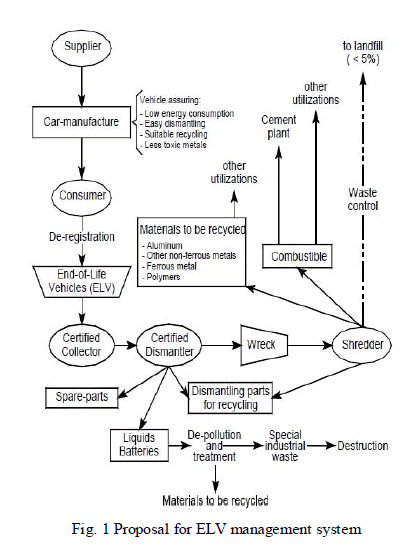 |
| B. Setting less Hop Count Transmission: |
| Multi-hop routing, packets have to experience multiple relays before reaching the data sink. Minimizing energy consumption on the forwarding path does not necessarily prolong network lifetime as some popular sensors on the path. So to avoid the problem in multi-hop routing we are setting the less hop count transmission. |
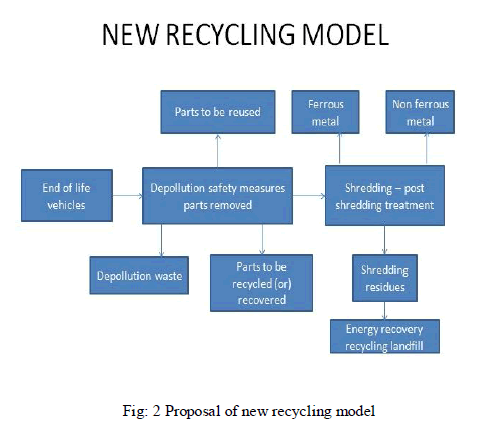 |
| C. Select sensor as RP: |
| A subset of sensors will be selected as the polling points, each aggregating the local data from its affiliated sensors within a certain number of relay hops. These PPs will temporarily cache the data and upload them to the mobile collector when it arrives. The PPs can simply be a subset of sensors in the network or some other special devices, such as storage nodes with larger memory and more battery power. |
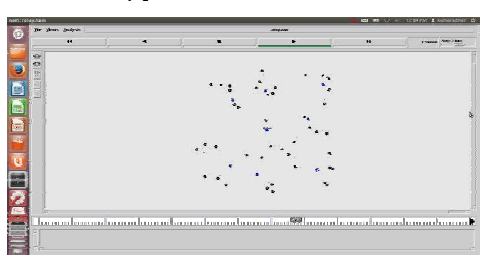 |
| D. Find and collect data from Rp’s: |
| Since the mobile collector has the freedom to move to any location in the sensing field, it provides an opportunity to plan an optimal tour for it. Our basic idea is to find a set of special nodes referred to as PPs in the network and determine the tour of the mobile collector by visiting each PP in a specific sequence. When the mobile collector arrives, it polls each PP to request data uploading. And then upload the data to M-Sink. |
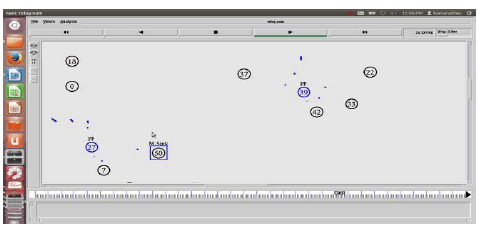 |
| E. Handover the data to Base Station: |
| A RP uploads data packets to the mobile collector in a single hop. The mobile collector starts its tour from the static data sink, which is located either inside or outside the sensing field, collects data packets atthe PPs and then returns the data to the data sink. Finally M-Sink handover the data to data sink, such as BS. |
 |
SIMULATION RESULT |
| In this section, it describes the simulation tool and various parameters chosen for simulation. The various performance metrics used to compare the performance of mobile sink moving in different methods. The speeds are uniformly chosen between the minimum and maximum speeds set to 0 m/s and 20 m/s, respectively. When the node reaches its destination, it stays there for a certain pause time, after which it chooses another random destination point and repeats the process. The simulation ends for 100s. The data traffic is generated by Constant Bit Rate(CBR) sessions initiated between the source and destination. All the nodes are assumed to have the same amount of battery capacity with full energy at the beginning of the simulation and initial energy of each node is 0.5 J. Transmitting power and Receiving power of each node are some 0 mW and 0.335mW respectively. |
| A. Energy Efficiency (EE): |
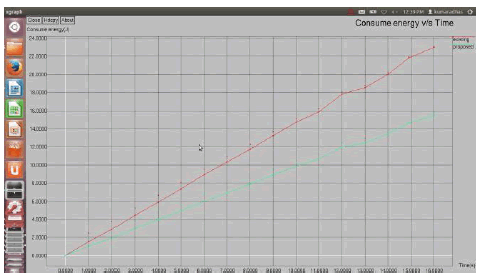 |
| Total received data measured in Bytes/Joule at the end of simulation. |
| EE=Total received data (bytes)/total consumed energy(Joules). |
| If battery capacity of node reaches zero then node will die. The network lifetime can be defined in many ways: It may be defined as the time taken for K% of the nodes in a network to die It might be the time taken for the first node to die. It can also be the time for all nodes in the network to die. The comparisons of our work are shown below. The comparison of energy consumption is shown in above Fig. It depends on overhead and load, the path failure mainly depends on due to lack energy of any one node or RP on selected path that sink moves. |
| B.Throughput: |
| In wireless sensor networks, such as transmission or packet radio, network throughput is the average of successful message delivery over a communication channel. This data may be delivered over a physical or logical link, or pass through a certain network node. The throughput is usually measured in data packets per time slot. It can be calculated as maximum throughout, maximum theoretical throughput, maximum sustained throughput, peak throughput, normalized throughput and so on. |
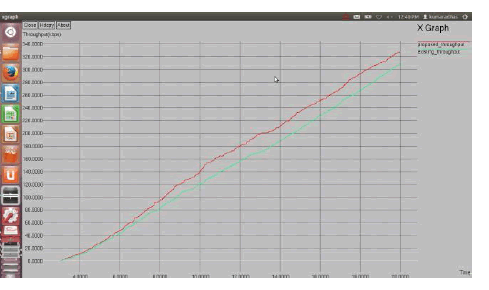 |
| The comparison of throughput is shown in above Fig. It depends on the rate of data packet flow in a particular channel that successfully delivered the data packet. |
| Throughput = File Size / Transmission Time (bps) |
CONCLUSION |
| In our work, we have done WRP, the method for controlling the movement of a mobile sink in a WSN.WRP selects the set of RPs from the sensor network that the energy consumption of sensor nodes is reduced and to prevent the formation of energy holes while assure sensed data are collected on time. We also compare WRP against existing schemes in terms of the difference between sensor node energy consumption. Our simulation results show that WRP uniformly distributes energy consumption and better than existing methods. As a future work, we plan to enhance our approach to include data with different delay requirements. This means a mobile sink is required to visit some sensor nodes or parts of a WSN more frequently than others while ensuring that energy usage is minimized, and all data are collected within a given deadline. Moreover, we plan to extend WRP to the multiple mobile sinks/rovers case. Also we generate emergency signal generation from sensor nodes that can be reached to sink through multi hop communication of RP. |